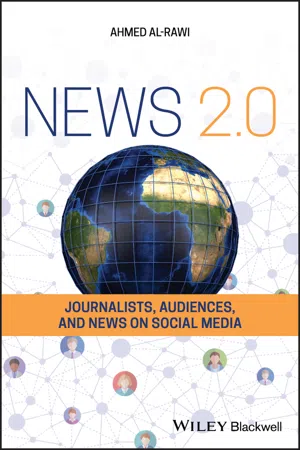“News 2.0” is no longer a new term. It has been in common usage for over a decade (Meikle 2008), but it is more relevant than ever in today's world. I define it as news made, disseminated, and consumed on Web 2.0 outlets, for social media platforms have become so popular for news organizations that they are now indispensable in the news business (Newman et al. 2012; Phillips 2012). Some scholars consider social networking sites (SNS) like Twitter as news media themselves, because of the opportunities they provide for sharing news (André et al. 2012; Hermida 2013; Al‐Rawi 2016a,b) and understanding the nature of “quantified audience” (Anderson 2011). In addition, many Internet users find SNS to be far more practical than visiting each news organization's individual website, because it allows them to find their news in one place, largely filtered based on their personalized and unique preferences.
Due to fierce competition and the changing news consumption behavior of people around the world, news organizations realized the need to change their traditional one‐way communication strategy by allowing viewers to interact with the news on their websites, which included creating comments sections, allowing users to customize the online platforms according to their own preferences (Chung 2008; Chung and Yoo 2008), and sometimes even publishing readers' online comments in their print versions (McElroy 2013). These were some of the first steps taken by media outlets to broaden their readership, before the meteoric rise of SNS. Later, they created multimedia platforms, in which the news experience is characterized by three main features: portability, personalization, and participation (Project for Excellence in Journalism 2010). Interactive features provided by news organizations include discussion groups, blogs, and forums (Boczkowski 1999; Schultz 2000), which have been described as “demassified forms of feedback” (Lievrouw 2001, p. 21). All of these tools have, on the one hand, enabled journalists to interact with their readers and, on the other, allowed readers to exchange their opinions among themselves (Constantinescu and Tedesco 2007, p. 449). Many newspapers and TV stations also provide hyperlinks to other topics and stories, enabling journalists to change the news frame in a way that “emphasizes broader social and political themes,” since the “[e]xpanded framing may prove central to re‐engaging an increasingly distrusting and alienated citizenry in a 21st Century democracy” (Pavlik 2001, p. 320).
What is important here is that news is read and shared much more than before; it has become a social experience (Redden and Witschge 2010, p. 181). Hermida calls this phenomenon “ambient journalism,” which refers to “social information networks that provide an asynchronous, lightweight and always‐on communication system … enabling citizens to maintain a mental model of news and events around them” (2010, p. 301). Goode notes that, in the world of ambient journalism, news stories are being “amplified, sustained and potentially morphed as they are re‐circulated, reworked, and reframed by online networks” (2009, p. 1293). Most commonly, news organizations share hyperlinks to stories posted online in order to direct traffic from SNS to their own websites, where users can comment using their Facebook and Google+ accounts (Goodman 2013, p. 48; Ju et al. 2013, p. 1). In this way, news content can be disseminated “virally” (Stelter 2007, para. 11). Further, SNS offer solutions to news organizations that are less problematic and costly than comments sections, which have become notorious for containing a great deal of incivility (Howell 2007). Braun and Gillespie (2011) call SNS “digital intermediaries,” because of their practical functions.
The interactive nature of social media has revolutionized the dissemination of news. The New York Times, as early as 2010, recorded people tweeting its articles 17 times per minute, equivalent to one tweet every four seconds (Harris 2010). Around that same time, the Associated Press was believed to attract more audiences to its YouTube channel than its website (May 2010). As for Facebook, in February 2012 it was found to attract higher traffic to the Guardian's website than arrived via online search engines such as Google (Phillips 2012, p. 669). Data on the frequency of readers' visits, the time they spend on a site, their gender and age distribution, as well as the most shared, liked, and commented‐on news stories are always important to news organizations (MacGregor 2007). Phillips believes this data “is now increasingly considered necessary to ensure that news is produced in a form that is capable of spreading virally” (2012, p. 669). As a result, many news organizations implement social media guidelines for their employees and hire social media specialists in order to maintain their image and identity and enhance their public relations efforts (Morton 2010; Steyn et al. 2010; Muralidharan et al. 2011, p. 228). Among the first TV stations to use Facebook to enhance its news dissemination was ABC News, which officially partnered with the site in 2007 to allow its users to “electronically follow ABC reporters, view reports and video and participate in polls and debates, all within a new ‘U.S. Politics’ category” (Stelter 2007). By 2018, CNN, for example, employed around 150 people to tweet the news (Garrison‐Sprenger 2008) and used its “Facebook Connect” service to increase its online audience...
